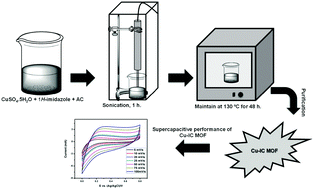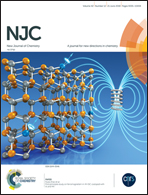Cost effective synthesis of a copper-1H-imidazole@activated carbon metal organic framework as an electrode material for supercapacitor applications
Abstract
The present work describes the synthesis of a copper-1H-imidazole metal organic framework (Cu-I MOF) and copper-1H-imidazole@activated carbon metal organic framework (Cu-IC MOF) via a simple chemical route under ultrasonication. The formation of the as-synthesized MOFs was confirmed by various spectral and analytical techniques. The electrochemical properties of the MOFs are examined for supercapacitor applications as an electrode material using Cyclic Voltammetry (CV), Galvanostatic Charge–Discharge (GCD) and Electrochemical Impedance Spectroscopic (EIS) techniques. Comparison of the results obtained from the CV and GCD studies reveals that the Cu-IC MOF has a specific capacitance greater than that of Cu-I, i.e. 753 F g−1 at a scan rate of 5 mV s−1 by CV and 733 F g−1 at a current density of 1 A g−1 by GCD for the Cu-IC MOF while 596 F g−1 by CV and 252 F g−1 by GCD for the Cu-I MOF. The Cu-IC MOF retained about 85% of its initial capacitance even after 2000 GCD cycles at 1 A g−1 current density. This observation proves that the Cu-IC MOF may be a potential electrode material for supercapacitor applications.



 Please wait while we load your content...
Please wait while we load your content...